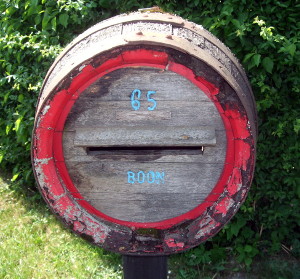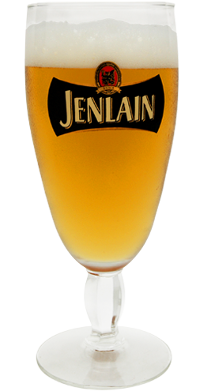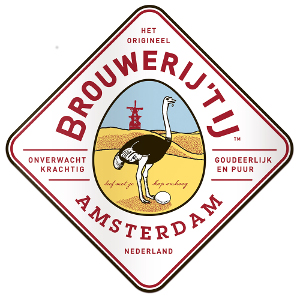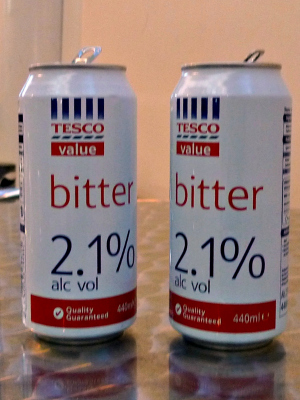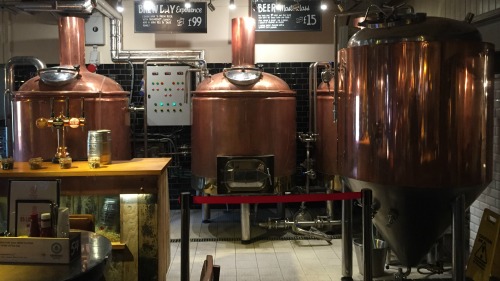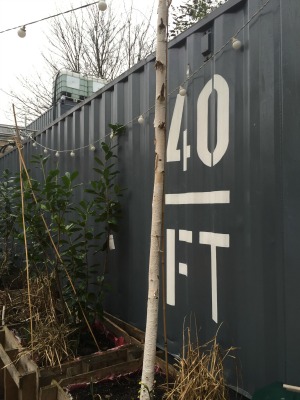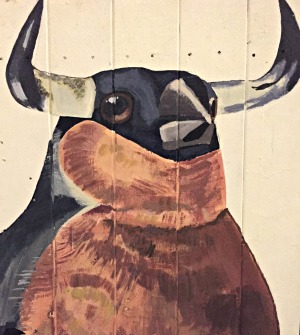
The Birmingham conurbation is the latest British city to rejuvenate its beer scene under the ‘craft’ banner, albeit several steps behind the likes of Bristol, Leeds and Manchester. But this is a city that’s also particularly rich in living examples of beer and pub heritage, demonstrating that, though today’s beer may be novel in style and a new demographic of people are buying it, craft brewing in Britain never really went away.
I went to Birmingham recently with a thoroughly contemporary remit: the Time Out website required a list of “the 10 best craft beer bars” and some good bottled beers to recommend, and I also planned on featuring new local breweries in a BEER magazine column. But while there I took the opportunity to tick off some longstanding entries on my bucket list by touring the region’s cluster of classic brewpubs too.
That cluster is in the Birmingham hinterland known as the Black Country, to the west and northwest of the city centre, in the boroughs of Dudley, Sandwell, Walsall and Wolverhampton. This rolling territory straddles coal seams and deposits of iron ore, and was already ‘proto-industrial’ in the 16th century, when there was a forge on almost every farm. By the 19th century it had developed into one of the great powerhouses of the Industrial Revolution, with a dense cluster of mines, steelworks and other metalworking industries like chainmaking.
The name dates from this period: contemporary accounts talk of a blasted land of spoil heaps and perpetual twilight, overcast by factory smoke in the daytime and lit by furnaces at night. J R R Tolkein, who grew up in south Birmingham, based his chief villain Sauron’s desolate domain in The Lord of the Rings on this landscape. Its name, Mordor, even translates as ‘black country’ in the author’s invented languages.
For better or worse, the dark lord has long departed. The last pit closed in 1968, and most of the heavy industry is now gone too. The Black Country is both much less black, and less economically prosperous. Nonetheless it retains a distinctive local character, and a texture which, if not quite semi-rural, is notably dispersed, with the patchwork of dense housing, open space and scattered former village centres typical of an ex-mining area.
Like metalworking, brewing was also once proto-industrial, often a sideline for farmers, publicans and other tradespeople. In 1830, small-scale commercial brewing got a boost as new legislation deregulated spirits-free ‘beer houses’, also entitled to brew their own supplies. And the development of the West Midlands drove a huge demand for beer, primarily as a refreshment for manual workers at a time when water was often unsafe.
Some small brewers evolved into major enterprises. The city of Birmingham itself became the home of two regional giants, Ansells and Mitchells & Butlers, which between them absorbed much of the immediately local competition before becoming key components of two of the ‘Big Seven’ national brewing groups, Allied and Bass Charrington respectively, in the later 20th century.
But the Black Country proved more resistant to such concentration, preserving the tradition of pubs with their own small breweries – what we now call ‘brewpubs’ – well into the 20th century. Only one survived into the real ale revival years of the 1970s, plus a couple of small production breweries with a scattering of pubs and a loyal local following: one of these, Simpkiss, was bought and closed by Greenall Whitley in 1985; the other survives today and is discussed below. But the local collective memory has persisted, and influenced the revival of brewing in a number of local pubs.
The idea of touring the Black Country might raise eyebrows but, for anyone with an interest in the past and present of brewing, it’s an essential visit. Trains are relatively sparse but there’s a dense and frequent bus network and, from a Birmingham base, it’s easy to find your way around at least four rewarding gems of brewing heritage in a day. All the following venues are in Dudley borough.
The Sarah Hughes Brewery / The Beacon Hotel

Beacon Hotel, Sedgley.
My first call was the Beacon Hotel at Sedgley, the only place I’d been before, though many years ago. This large and handsome pub is airily located near the top of the hill known as Sedgley Beacon, one of the highest points in the area. The pub is celebrated among other things for its unspoilt 1920s multi-room interior, with some Victorian panelling and other features, and a rare serving cubicle in place of a bar, where glasses are passed precariously through low glazed hatches. It’s both Grade II listed and on the CAMRA/Historic England national inventory of pub interiors. In keeping with tradition, there’s no food other than filled rolls, known locally as cobs.
The Beacon is a fine example of a successfully revived brewing tradition. Rebuilt in 1865 as a homebrew house, it was owned and operated for 30 years from 1921 until her death by Sarah Hughes, who bought it from the compensation she was paid on the death of her miner husband in a workplace accident.
As a female brewpub proprietor and brewer (or ‘brewster’ if you prefer the old Dutch-derived feminine form), Hughes wasn’t at all unusual. Many of her contemporaries in the trade were women. Interestingly, up until early modern times, most brewing was carried out by women – it was only when the industry grew from a domestic to an industrial scale that it came to be seen as men’s work. But women continued to play a major role as licensees, including taking on brewing responsibilities where required.
The brewery was abandoned a few years after Hughes’ death, in 1958, but the pub stayed in the family, and in 1987 her grandson John Hughes stumbled on her recipe for dark mild. He restored both pub and brewery, reviving Sarah’s name for the latter.
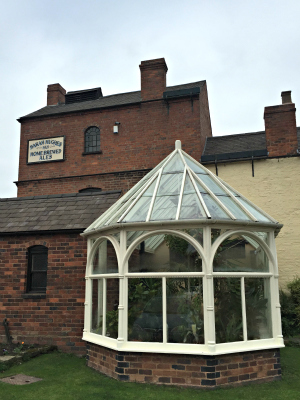
Sarah Hughes tower brewery seen from the rear of the Beacon Hotel.
I already knew the building behind the pub was a scaled-down tower brewery worked by gravity in classic Victorian style – it’s clearly visible from the outside – but I’d always assumed its equipment was modern. This time I was lucky enough to turn up when brewery manager Mark had a spare few moments to show me round, and I discovered much more working heritage than expected.
There’s now a small electric winch to lift ingredients to the second floor-level brewhouse, but the last few metres up to the grist case in a wooden loft above are still accomplished by hand. The core beers are made exclusively with Maris Otter pale and crystal malt from Fawcett’s: this is possibly the only brewery I’ve ever visited without a sack or two of something from Weyermann lurking around.

Mash tun at Sarah Hughes brewery.
The 8-barrel (13 hl) mash tun, now put to use three times a week, is a simple wooden-clad vessel custom-made for the 1980s restoration, though the hot liquor tank, concealed under a nearby hoarding, is original. Once it was heated by solid fuel; it’s now gas-fired but still has to be left on overnight. Sparging is through a perforated tube around the inside rim of the mash tun. The mash is stirred by hand using an old-fashioned paddle, and there’s not even a hatch in the vessel, so the spent grains have to be dug out the hard way.
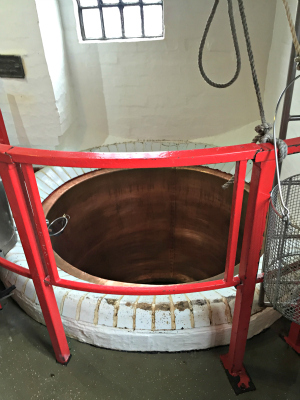
Copper at Sarah Hughes brewery.
The copper is the star of the brewhouse, a genuine 1930s copper vessel recessed into the floor beside the mash tun, in a brick surround. It’s also now gas-fired, though with direct flame, a method known to contribute to the character of the beer as it causes uneven caramelisation. There’s a modern heat exchanger for running off the hopped wort, but its predecessor is on display downstairs: it looks like an ancient radiator. Unlike on modern versions, the channel for the wort was on the outside, as this was easier to clean.

Fermentation vessels at Sarah Hughes brewery: old pub beer tanks.
The cluster of dinky cream-painted fermentation vessels dates from the 1980s but is still something of a blast from the past, as they’re tanks originally used in pubs to store an obsolete format of tank beer (unlike modern tank beer systems, these tanks had no inner liner and contained beer that was usually bright and dispensed under gas pressure; in its day it was regarded as something of a halfway house between keg and real ale).
After primary fermentation the beer is cooled in the fermenter using iced water and conditioned for a few days, then transferred to a racking vessel where it’s kept overnight before being racked into casks, and conditioned for at least a week in the pub cellar. It’s normally fined but the brewery has been known to ship unfined beer to order.

Barrels (right) and kilderkins at Sarah Hughes brewery.
The racking room boasts a rare sight: not only substantial 18 gallon (82 l) ‘kilderkins’, double the size of a standard 9 gallon firkin cask, but even more beefy casks known as ‘barrels’, doubled in size again to 36 gallons (163.5 l). British brewers, when they’re not thinking in hectolitres, readily calculate in terms of these brewer’s barrels, but I wonder how many of the current generation of brewers have actually ever seen one. The barrels are used for the most popular beers sold in the pub, but some of the kils go to other outlets.
The big wood-panelled ‘smoke room’, thankfully now smoke-free, is a fine place to sample the beers. Of these, the flagship is still the dark mild inspired by that recovered recipe, Sarah Hughes Dark Ruby, brewed to a robust 1920s strength of 6% ABV. I’ve long regarded this as a benchmark of the style.
It’s a deep amber-brown beer, darkened with just a touch of invert sugar and caramel, with a smooth light fawn head. There’s dark brown toast, tart fruit and caramel on the aroma, and a smooth, inky palate of some complexity, with hints of port, cherry and light citrus pith besides chocolate and coffee. Charred flavours show on the finish which turns quite dry and lightly bitter, though still with a rich maltiness. See also earlier review.
Now marginally a better seller is the brewery’s special bitter Surprise, or Sedgley Surprise to use its full name. This is a modern recipe, at a substantial 5%, but its warm colour fits the local preference for light-coloured bitters. It’s a smooth beer with lemon-tinged hops and a bit of peachy fruit, with a very firm rooty dryness emerging at the back of the throat and a hint of toast. It’s just a little bit worty, though, for my tastes.
The other regular is Pale Amber at 4%, also a warm gold colour. This is a very tasty bitter with earthy and orangey hop notes on the aroma, a full-bodied palate with a hint of diacetyl and a bracing bitter hop note emerging, and some lettuce bitterness in the finish balanced with good malt.
There’s also a winter red-amber seasonal, Snowflake, at 8%, which I was too early to catch this time around. When I last drank this a decade or so ago I found it winey and slightly figgy, with hints of stewed apple, ginger and herbal hops on the finish.
Fownes Brewing Co / The Jolly Crispin
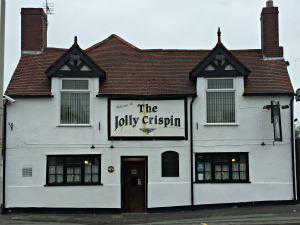
The Jolly Crispin, Upper Gornal.
A brisk stride or a bus ride south of the Beacon, in the linear village of Upper Gornal alongside the old turnpike road to Dudley, is the Jolly Crispin. Originally built as his own home by a local builder, who then diversified into selling beer, this has been a beer house since the 1830s, and may once have brewed on its own account.
Badly damaged by a fire in 1936, it became a Simpkiss pub in 1940. Unloved and deteriorating as a neglected corner of Greenall Whitley’s estate, it was bought free of tie and restored in 1997 with a focus on cask beer. It’s changed hands twice since then, and is now part of the Newport Pub Company, but the beer focus has been developed further, boasted by the presence since 2012 of an in-house brewery.
This is Fownes Brewing Company, pronounced ‘phones’ (with or without a Black Country accent) and named after the homebrewing brothers who run it. It’s actually a separate business from the pub, operating from an outhouse at the back, which originally held a tiny 100 l brewhouse, upgraded to the current 4 hl (2.5 barrels) in 2014.
Tom and James Fownes are fantasy fiction fans: their products are dubbed ‘Dwarfen Ales’ and there’s a designated company storyteller. They’ve established a good reputation locally as one of the first of the more contemporary ‘craft’-inspired commercial brewers around this way, but they favour English hops, using several new varieties, and aren’t afraid to re-interpret traditional styles.
Crispin’s Ommer, the house beer they brew for the pub, is a case in point. It began life as an appealing but unchallenging golden bitter that fitted in well with the local style. “We developed it by testing several batches with customers of the pub,” Tom told me, “and we were surprised that they kept on asking us to make it hoppier, so it ended up at 60 IBUs.”
The 4.1% mid-gold beer has a sticky white head and a slightly floral and waxy lemon-tinged aroma with definite resin notes. There’s sweetish fruit salad and apple on the palate, with a good sweet balance for the resinous hops, and a hint of coloured malt in a bready and hoppy finish that develops a crisp but not overpowering rooty bite.
I’ve not yet tasted the Fownes’ other beers, but their porter King Korvak’s Saga has won awards, and they also brew a ruby ale, Firebeard’s Old Favourite No 5, inspired by the original Wychwood Hobgoblin. An ommer, in case you’re wondering, is a runic hammer.
Although not especially remarkable as a building, the pub is well worth visiting for its traditional and welcoming atmosphere – low ceiling, horse brasses, dartboard – and a range of up to nine cask beers, sometimes including more Fownes brews besides the likes of Castle Rock, Dark Star and Oakham.
The Old(e) Swan / Ma Pardoes

Old Swan, Netherton.
The Old Swan at Netherton, a village south of Dudley now ringed by nature reserves wrought from the ruins of industry, is one of Britain’s most significant brewing heritage sites. It’s one of the four historic brewpubs still in operation when CAMRA was formed in 1971, although its record since then isn’t quite unbroken.
This is one of those areas where many pubs have more than one name, and the one used by locals is rarely the one on the pub sign, causing endless confusion to visitors. The Swan, which has been licensed since 1835, owes its more familiar name, Ma Pardoe’s, to Doris Pardoe, who took on the management of the pub with her husband in 1931 and presided for many years after his death in 1952, eventually becoming the owner in 1964. She died in 1984 at the age of 85, having passed the business on to her daughter and son-in-law the year before.
Pardoe, incidentally, wasn’t a brewster. The Old Swan has probably always had a brewery, which was rebuilt alongside the rest of the pub in 1863. But although the Pardoes were experienced licensees when they took it on, they had no brewing knowledge, so retained the existing head brewer and then employed others. I didn’t visit the brewhouse, but you can glimpse it through the window of one of men’s toilets, a solid tower structure at the back.
The pub went on the market very soon after the death of its longstanding host, and passed subsequently through several hands. CAMRA gave financial backing to prevent it being snapped up and rationalised by a big brewery, and it even played a role in the convoluted history of pioneering microbrewery Pitfield’s, which was based here briefly in 1987. But all of these well-intentioned initiatives foundered. Brewing ceased in 1993 and the pub was finally closed in 2000.
It was soon bought by pubco Punch, who in this case did the right thing in recognising its heritage and uniqueness were the key to its future success. The pub and brewery were restored and reopened in 2001 under the leasehold of Tim Newey, a former employee of Doris Pardoe, and in this incarnation, they’ve flourished afresh.
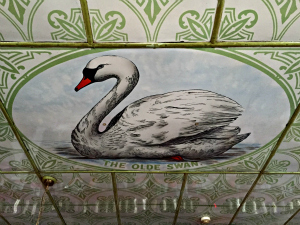
Unique enamel ceiling at the Old Swan, Netherton.
It’s a sprawling place, with numerous rooms that once had separate entrances and now interconnect only in a convoluted way. The showpiece is the front bar, which retains much of its Victorian character and fittings, including a unique decorative enamel ceiling with an image of a swan, and an elderly stove. Behind this is a more intimate smoke room with engraved glass and an elaborate fireplace. These and other features ensure its registration on the national inventory of pub interiors.
The additional rooms to the left of these are also decked out in traditional style but originate from the 1980s when the pub expanded into a former wool shop next door. And, perhaps wisely, the Swan now departs from tradition by serving a full food menu, both at the bar and a table service restaurant, the Granary Loft, upstairs.
To add to the naming confusion, the brewery styles itself Olde Swan, with a suitably archaic extra ‘e’, when it ships its beer to other outlets – in the pub, it’s dispensed Victorian-style from unlabelled handpumps.
Unusually, the flagship beer, Original, is a light mild. At only 3.5% ABV, this is a very easy-going and traditional pale yellow beer, with only a hint of hops on a worty glucose-tinged aroma, and a full-bodied grainy palate with some lemon hop notes. A well-integrated finish is slightly grassy and earthy but very mild and slightly sweet, though not at all cloying, and overall as thirst quenching as beer gets.
The dark mild, Dark Swan, is a stronger 4.2%. It’s amber-brown with burnt toast and blackcurrant on the aroma and some deep toasty notes and brown sugar on the palate. The finish is very mild with light rooty hops and a hint of roast. My sample had a just-detectable funky and acidic note. I’m normally a great fan of dark milds but in this case I concede the lighter alternative is superior.
Entire is a term normally associated with porter, but in Netherton it designates a 4.4% best bitter, a rich gold colour, with lots of grain and sweet malt on the palate and a dash of spicy pepper on a short finish. The beer was a little too plain for me, with a couple of odd artefacts that suggested a very warm fermentation and not quite enough conditioning.
There’s also a stronger 5.2% bitter, Bumblehole, which is greenish-gold with a slightly sharp lemon squash note and a dose of diacetyl too, a pleasantly nutty palate and a lightly honeyed finish. All are worth sampling, but Original remains the most interesting and drinkable beer.
The Vine / The Bull and Bladder

Bathams is the last traditional vertically integrated family brewery in the Black Country, and the Vine, almost invariably referred to locally as the Bull and Bladder, is its brewery tap. It’s at Brierley Hill southwest of Dudley, only a short step from the massive new Merry Hill mall and leisure park, but seemingly a world away.
Like the venues discussed above, Bathams traces its history back to the 1830s legislation that encouraged beer houses. This prompted butcher Charles Attwood to convert part of his shop at Cradley, a little further south, into a beer house, and to begin brewing. Trading in both meat and beer was a relatively common practice at the time: the Vine is another former butcher’s shop, thus its nickname.
In 1882 Daniel Batham, from a local nail-making family, and his wife Charlotte, who was an accomplished home brewer, took on the Cradley pub, which by now was an inn known as the White Horse. The Bathams gradually expanded, acquiring other pubs including the Vine, which they bought in 1905 from another member of the Attwood family. The pub and its brewery, known as the Delph Brewery, were rebuilt in 1912, the latter eventually supplying a small estate which currently stands at 10 pubs.
This is another classic traditional pub, with a cheerful but dignified exterior well-known for the quotation from William Shakespeare displayed above the cornice: “Blessing of your heart, you brew good ale.” Inside is another gobsmacking heritage interior, though considered only of regional importance. There are four rooms, including an old school public bar with fixed bench seating barely altered since its Edwardian installation, old fireplaces and attractively stained windows. Gargantuan rolls and pies are the only food.
Once, Black Country brewers would all have produced only dark, sweetish mild ale, and perhaps the odd stronger beer. Gradually, though, paler beers crept into local brewing practice, influenced by fashions elsewhere. Bathams stuck exclusively to mild, and a strong ale for Christmas, right up until the 1950s. In 1951 it acquired a pub called the Swan in Chaddesley Corbett where pale ales were popular, and finally diversified to meet this new demand. The resulting beer, Bathams Bitter, is now the one for which it is most famous.
Like the cask bitters already encountered above, this one is not the stereotypical brown: it’s a warm mid-gold. ‘Golden ale’ is often assumed to be a modern invention, formulated to attract lager drinkers, but the original pale ales from which bitters descended were golden in colour, like many American pale ales today, made entirely or near-entirely from pale malt. And how such beers must have stood out as something new and exciting amid a sea of dark mild.
Served on cask at the Vine, the 4.3% bitter has a dense and creamy clean white head – sparklers are the norm in this part of the world – and a restrained aroma of light malt with perhaps just a hint of diacetyl and cream cheese. A sweetish palate is balanced by a burr of lightly tangy hops from the start, and there’s coating malt and a gentle but distinctive hop bitterness on the finish.
My sample was also in superb condition, at cool cellar temperature with just the right level of carbonation. Even more than the Olde Swan Original, this is a straightforward but beautifully integrated, refreshing and very moreish beer, and you can easily understand its appeal to a thirsty worker.
Bathams still offers a Mild at 3.5%, a dark chestnut glassful with a light beige head. This has a notably roasty aroma with hints of coffee, and a malty, nutty and again quite plain palate with gentle tangy bite. There’s a touch of caramel, light hops and a mineral hint in the lingering finish, though the tanginess becomes slightly thin and astringent, and it doesn’t tempt you back as much as the bitter.
And this despite the fact that I paid only £1.19 for a half – a penny less than I’d paid for the same quantity of the same beer a decade earlier at the Great British Beer Festival.
Black to the future?
The day after my dash around the Black Country, I found myself in the City Arcade, just off Corporation Street in Birmingham City Centre, where the newly-laid tram tracks are poised to transform the local street scene, and likely for the better. I was visiting the then-not-yet-opened Tilt, a refreshingly ambitious cutting edge craft beer, coffee and pinball-themed venue run by two youthful enthusiasts, Kirk Sadler and Richard Kimberley.
Tilt, with its bold, bright and clean design, its keg-only dispense via post-industrial bar mounts and its plans for a list of rare lambics and sours, seems to represent a world of beer a long way from the fussy heritage bar backs and unpretentious, old-fashioned session beers of the Black Country brewpubs.
As the US-inspired craft beer revolution sweeps the old beer countries of Europe, I’ve found myself hoping again and again that beer drinkers and brewers will come to appreciate both worlds and everything in between, recognising the threads that, despite appearances, link them together. Indeed if it hadn’t been for the Bathams and many other old-established European brewers sticking to styles and methods that well merit the label ‘craft’, we would likely not be enjoying the current abundance.
One particularly pertinent example springs to mind. London brewery Beavertown has become one of the most admired of the new generation of contemporary brewers since it opened in 2012. Among other things it’s been an early adopter in the UK of craft beer in cans, which come with striking designs as well as flavourful and alluring contents.
Yet Beavertown’s founder Logan Plant grew up in the Black Country, and first acquired a love of beer through drinking the local cask brews. One of his most popular beers, session pale ale Neck Oil, began as an attempt to replicate none other than Bathams Bitter.
The best value way to explore the Black Country is with a bus and metro pass or Day Tripper card: for details and journey planner see the Network West Midlands site.



